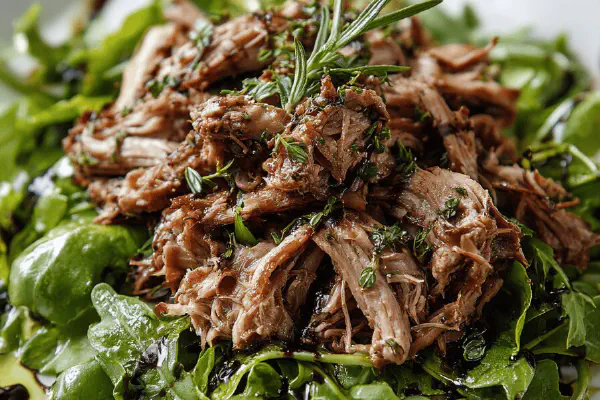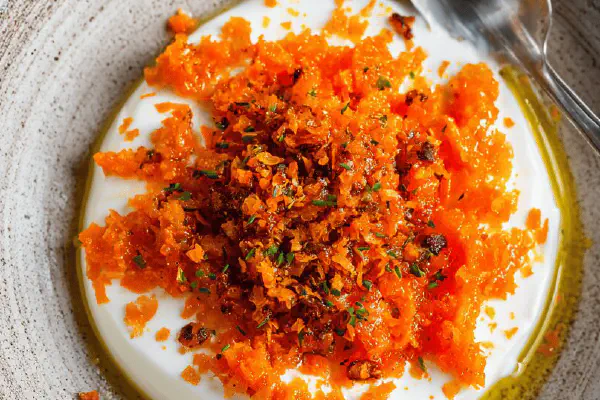Quick Confited Cherry Tomatoes

By Emma
Certified Culinary Professional
Ingredients
- 60 ml olive oil
- 20 ml lemon juice
- 20 ml maple syrup
- 2 cloves garlic, slightly crushed
- 1 pinch chili flakes optional
- 450 g cherry tomatoes on the vine
- 15 ml fresh thyme leaves
- Salt and freshly ground black pepper
About the ingredients
Method
- Heat olive oil gently in a large heavy skillet over medium-low. Add lemon juice, maple syrup, garlic, chili flakes. Swirl and warm until fragrant but not sizzling aggressively. Salt and pepper now to season liquid.
- Add whole clusters of tomatoes. Nestle them so skin just touches pan. Cover loosely. Slow simmer for 12 to 15 minutes. Watch for skins to split, juices bubbling thickly—the telltale signs. If liquid dries too quick, splash a spoonful water. Don’t rush.
- Remove lid. Test softness with a gentle press on a tomato; should be tender but hold shape. Garlic should have mellowed, infusing sweetly. Spoon warm tomatoes and sticky sauce onto a dish.
- Sprinkle fresh thyme leaves before serving. Eat warm with grilled poultry or fish. Bonus: leftover infused oil excellent drizzled over crusty bread.
Cooking tips
Chef's notes
- 💡 Heat oil gently. Never blast the pan. Watch for faint aromas, garlic softening, no smoking. This sets the tone; bitter scorched garlic ruins base. Chili flakes wake it up but sparingly. Add salt early to let oil absorb flavor inside tomatoes; pepper last to keep freshness. Slow simmer means patience. If pan dries, splash water or broth carefully but no drowning sauce. Tomato skins cracking, soft pop sounds tell you timing—listen close here.
- 💡 Use fresh thyme leaves crushed lightly. Releases oils without overpowering. Dry herbs lack punch. Leafy clumps better than dust. Cherry tomatoes best on the vine for holding clusters together but can remove stems if easier. Ripe but firm needed; too soft they turn mush. Swirling the pan helps coat evenly but don’t stir roughly, crushes fragile skin. Remove lid last second for evaporation if sauce too loose; works better than long uncovered cook that dries everything out.
- 💡 Maple syrup stands in for honey here to tame sweetness and add earthiness. Adjust quantity to taste but not too much, sauce thickens quickly. Lemon juice brightens, replaces vinegar acidity for softer snap. Fresh squeezed always better—not bottled which can be harsh. Garlic should be crushed lightly, not minced; keeps chunks intact, releases mellow garlic essence during cook. Chili flakes optional; omit if sensitive but they bring background heat if wanted.
- 💡 Watch tomato texture carefully. Gently press a cluster or single tomato against pan rim or your finger. Should yield to pressure, soft but hold shape still. If too firm, cook a few minutes more. Sauce must thicken and coat tomatoes like syrup. When you see bubbles forming thickly around tomatoes and skin weakening, ready to remove heat. Remove garlic chunks or leave for rustic texture. Leftover infused oil useful for bread or veggies; store in fridge but use soon.
- 💡 Don’t rush simmer. Medium-low heat, slow cook. Fast boiling ruins soft texture, bursts tomatoes. Use heavy skillet for even heat distribution, avoids hot spots. Cover loosely to trap steam, let evaporation happen but not too fast. Overcrowding pan is good here, helps steam effect instead of frying; juicy confit not frying char. Serve warm and straight away as reheating can make tomatoes mushy quickly.
Common questions
Why no vinegar used?
Lemon juice replaces vinegar. Softer acidity, less harsh. Adds brightness without sharp edge. Vinegar changes feel, tougher skin sometimes. Lemon suits gentle simmer better.
Can honey replace maple syrup?
Yes but maple adds earthiness, less cloying sweetness. Honey works fine but cooks thicker sauce, sweeter taste. Adjust quantity down if honey. Both sweeteners break acid bite.
Tomatoes burst too soon, what to do?
Lower heat. Patience key. Check pan temp; don’t let oil fry hard. Too hot cooks too fast, skin pops early. Use medium-low, cover loosely, crowd pan to slow steam. If dry, add splash water but no drown.
How to store leftovers?
Tomato confit best fresh but oil can keep few days in fridge. Store in airtight container. Reheat gently or use cold oil for dressing salads or bread. Don’t freeze; tomato softens too much, texture lost.



